Historic Gold Mining District on the Fringes of Yellowstone
An Early History of Bear Gulch & Jardine, Montana
Copyright Robert V. Goss, 2018

Jardine, Mt 1925
A few cabins and part of the old Revenue mill (center left) still remain in this burg 5mi up in the mountains from Gardiner.
The hill on right is Mineral Hill, site of much of the mining activity. |
" . . . and finding also a hairless cub, called the gulch Bear.”
|
Eugene S. Topping, in his Chronicles of the Yellowstone, a classic 1885 history of the greater Yellowstone Valley, claimed that in 1863 a group of thirty miners lead by George Huston prospected their way up the Yellowstone River from the mining community of Emigrant Gulch and continued past Soda Butte toward what later became the New World mining district. Attacked by Indians who ran off all their horses, the prospectors cached their excess supplies and continued afoot toward Clark’s Fork with one lone jackass. Finding a few prospects, but no pay, they returned back along the Yellowstone. Topping related that, “On the way they found fair prospects in a creek on the east side of the Yellowstone, and finding also a hairless cub, called the gulch Bear.” Even though today the creek goes by the name Bear Creek, the name Bear Gulch, also referred to as the Sheepeater District, still identifies the classic mining areas around the town of Jardine, Montana.
George Huston, from Harpers Weekly, 11-17-1877
Guide for Army during chase of Chief Joseph to the Bear Paw Mts.
|
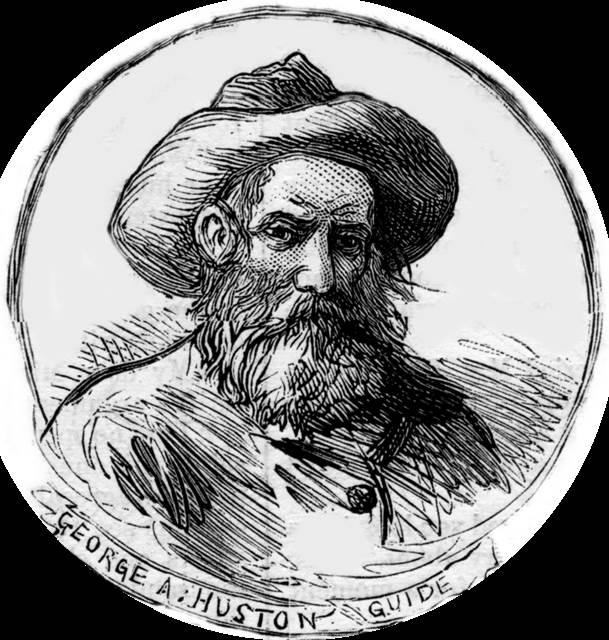 |
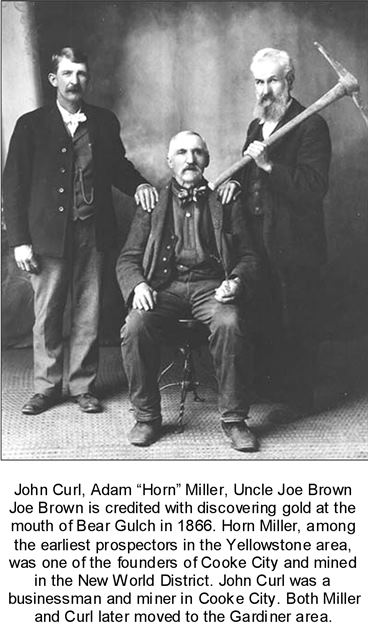 |
Sporatic prospecting around Bear Gulch continued uneventfully the next few years after Huston’s journey until Joe Brown and partners John Zimmerer, Dan Royer, and an unknown man struck rich, gold-bearing gravel in 1866 on a bar at the mouth of Bear Gulch, as it empties into the Yellowstone River. They staked a claim and reportedly took out $8,000 in gold. News traveled quickly in the mining communities and in 1867, Lou Anderson, A.H. Hubble, George W. Reese, Caldwell, and another man discovered gold in a crevice at the mouth of the first stream above Bear Gulch, and named it Crevice Gulch. That same year George Huston returned to the area and built a cabin on Turkey Pen Flats across the Yellowstone River from Bear Gulch. Living on land that later became part of Yellowstone National Park, Huston’s cabin is believed to be the first white residence in Yellowstone.
Click Here for Joe Brown Bio, Page 1 - Page 2
From Joe Brown's obit in 1913, Livingston Enterprise:
"A gentleman of the old school; the blazer of trails, the hardy pioneer; the man inured to privation, hardship and suffering; the man without fear or favor, who tells you if he likes you or if he does not; the man who looks you squarely in the eyes, tells the truth in return; the exemplification of honesty, sincerity and frankness - a race disappearing with the advance of civilization as rapidly as the buffalo, and destined in a few years more to live as a remembrance and not as a reality."
|
|
Meanwhile, placer mining was conducted on gravel bars along the creek, or in ancient channel deposits accessed by tunnels or drifts into the hillsides. During the years 1875-77, Joe Brown and other miners built over 3000 feet of ditch to carry water to the various gravel bars they were working. In either 1870 or 1874, depending on sources, Joe Brown and James Graham discovered quartz gold deposits in upper Bear Gulch on a hill later known as Mineral Hill. Although not developed for several years, the Bozeman Times reported in July 1877 that Wm. Heffner, Joe Brown, and James Graham were successfully crushing ore with a crudely-built, mule-drawn device known as an arrastra, based on a primitive design from the early Spanish and Mexican miners. The paper also noted that George Huston and Stoker Henderson would have their arrastra operating by October.
|
Arrastra, From Pictorial History of California, Frost 1850
|
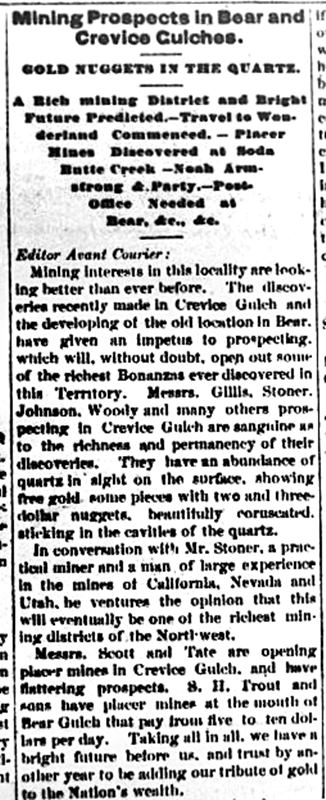 |
Hard rock mining escalated in 1878 when Z.H. “Zed” Daniels and three other men began working a quartz lead on Bear Gulch and built an arrastra to process their ore. In July the Bozeman Times reported that George Huston, Jimmy Dewings, and Joe Brown discovered a “fine gold lead . . . [that] panned out one dollar to the pound of rock.” A later article described a 9-foot vein with free gold running through it; a 4-ton run through the arrastra yielded $50 per ton. In 1879 the following mines were recorded at Bear Gulch: Legal Tender (Joe Brown); The Wonder of the World (Beattie, Anderson, and Lovely); The James Graham Lode; Joe Brown & Graham; The Monitor; The Mountain Bride; The Coan & McCauley Lode; The Mountain Chief (Geo. Huston); The Champion Lode; The Summit Lode; The Great Western; Mountain Chief (Brown, Huston, & Graham); and the Home Stake.
|
|
Various newspapers touted the richness and auspicious future of both Bear Gulch and Crevice Gulch, where similar successes and operations were occuring. The Bismarck Tribune in May of 1879 claimed, “The belief is that erelong Bear Gulch is destined to become one of the richest camps in the Territory.” In April of that year a new town site was being laid out with corner lots going up, a harbinger of anticipated stability and prosperity. Outside investors were now beginning to see the potential of Bear Gulch and as a sign of things to come, Huston and Dewings sold a third of one of their claims for $3500. Huston went on to concentrate his efforts in the New World Mining District, amassed dozens of claims, and became one of the original founders of Cooke City.
Bozeman Avante-Courier, 5/22/1879
|
|
In 1882 Major George O. Eaton and a man named Sturgess formed the Bear Gulch Placer Co. and filed articles of incorporation in Gallatin County with capital of $40,000. Eaton bought out Brown’s Legal Tender mine and over the next few years purchased other mining properties. His crews tunneled into the canyon walls following old river channels in search for placer gold. Eaton also began hydraulic mining in 1884 on Joe Brown’s 40-acre placer claim on Bear Creek, about three miles below what would later become the town of Jardine. Installing equipment served by 1200 feet of 12-inch pipe with a vertical drop of 400 feet through a six-inch nozzle, it was reported to be the most powerful hydraulic placer operation in the world. Blasting away huge sections of the canyon walls in the quest for auriferous bounty, Eaton realized few riches from his efforts and left a scarred landscape, still visible to this day. Changing direction, Eaton built the first quartz mill in Bear Gulch, a five-stamp combination mill to process the oxidized ores from the various lode claims. The mill operated successfully for about two years, but shut down around 1886 due to internal company dissention and the difficulty in hauling ore to the Cinnabar railhead
Above: Hydraulic mining on Bear Creek. FJ Haynes photo, 1885
Below: George O. Eaton, nd
|
|
|
Minimal organized mining efforts occurred until 1890 when the firm of E.D. Edgerton and W.E. Jewell of Helena took over the operation and added five stamps to the mill. Operating successfully for three years, the operation was shutdown during the Panic of 1893 and the resulting economic depression. By 1895 a few mines and two stamp mills were again in operation. In the midst of the mining operations, a few businesses had been established, including a hotel, sample room, general store, and four log cabin residences belonging to George Welcome and two other men. Despite promising discoveries by Uncle Joe Brown and others, the community remained relatively quiet until 1898, when the arrival of Harry Bush, a native of England and active in the South African mines, arrived and inaugurated a new era in Bear Gulch. Backed in part by Canadian capitalists, he secured a lease on the Legal Tender mine and the Edgerton & Jewell properties on Mineral Hill. Bush organized the Bear Gulch Mining Company in August, 1898, and began buying additional claims that included the Sowash mine on the same vein as the Legal Tender, the Revenue from George Phelps, and five mines from George Welcome. Bush enlarged the Eaton mill to twenty stamps, attracted additional investors, and layed out the townsite of Jardine. New businesses developed and the mining district boomed. With the beginning of the 20th Century close in sight, a new epoch was emerging that would experience the cyclic triumphs and failures, joys and sorrows, so typical of the mining industry.
|
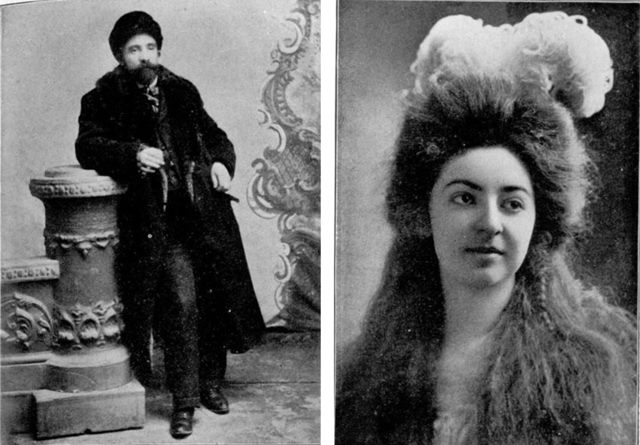 |
Harry Bush was born in England in 1858 and appears to have spent some time involved in mining activity in South Africa. Living in Spokane, WA around that time, Bush and his wife Adeline arrived in the Bear Gulch camp on July 28, 1898 and instituted a frantic pace of promoting activity that was to transform the small Bear Gulch camp almost overnight. The Livingston Enterprise described Harry Bush in the following manner: "It was at once evident that he possessed all the zeal and enthusiasm for the establishment of a foundation for the mining industry of Bear Gulch, one that could breast any of the former difficulties which had existed there previously."
[Jardine Cultural Resource Survey, 1982]
[Photos from Livingston Enterprise, 1Jan1900]
|
In 1895 a new post office was established at Crevasse with Mrs. M.E. Cowell as postmistress and on Dec. 9, 1898 the community of Bear Gulch became known as Jardine, when the post office was established with J. B. McCarthy as postmaster. This gentleman also had a general store, while other businesses in town included a hotel, saloon and barber shop. Additional business enterprises followed later in the summer. Walter Hoppe leased the Bear Gulch Hotel, built 1898-99 by John Jervis, and operated the hotel until Hoppe’s death in 1905, whereupon it reverted back to Jarvis. A correspondent writing from the town about the middle of October stated that 100 buildings were then in existence or in course of construction, and that the mining company contemplated the erection of thirty more cottages. At its peak the town boasted of a population of 500-600 souls. A Cultural Resource Survey of the area conducted in 1982 claimed that, “Within a year [1898-99] there were 130 new buildings, including two hotels, three mercantile establishments, office buildings, a mine company office, a guest house, a school and work started on a new mill. A water system and telephone service soon followed.” A hydroelectric dam was built on Bear Creek in 1903 near the mouth of the creek that produced electricity to the mines, businesses and residents of the Jardine area until 1948.
|
|
|
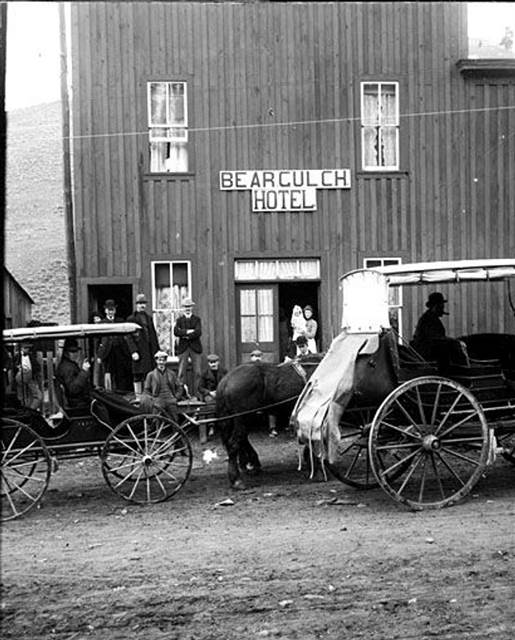 |
 |
Town of Bear Gulch, ca1895
Courtesy Montana Memory Project |
Bear Gulch Hotel, ca1903
Keystone-Mast Collection, UCR |
Bear Gulch Hotel & Saloon, ca1899
Livingstone Enterprise, 1Jan1900 |
Ad for Bear Gulch Hotel, Proprietor Walter M. Hoppe
R.L. Polk Guide, Park County, MT, 1900
Right: Brass Bear Token,
believed to be from The Bear Gulch Hotel
|
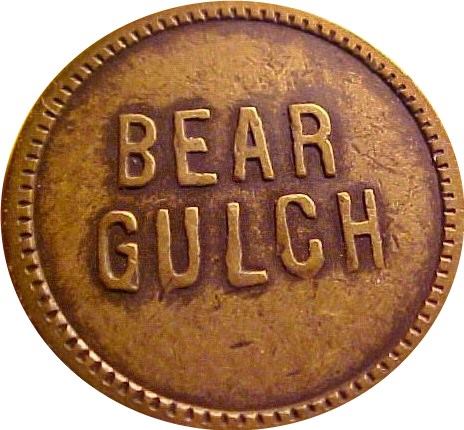 |
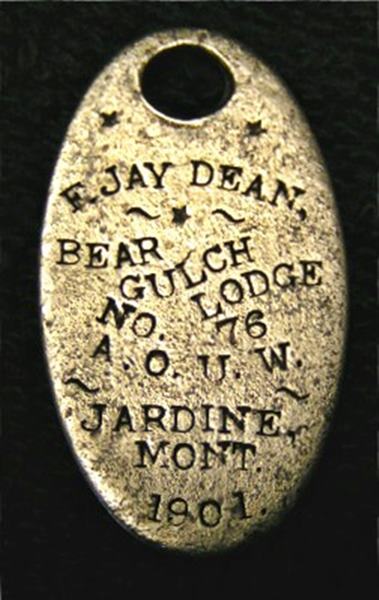 |
Around the turn of the century, George W. Welcome, who was an active businessman in Cinnabar, Aldridge, Horr and Gardiner, had also been busily involved in a number of mining activities on the mountain He was variously reported to have kept a hotel, saloon (Saloon Keeper on 1900 Census) and merchandise store in Jardine. Frank Jay Dean kept a mercantile establishment that unfortunately burned to the ground, along with the attached post office in early June, 1904. An article in the Anaconda Standard of Oct. 29, 1899, reported that, “the firm of McCarthy and Dean, who conduct a large general store at Jardine, and who are two of the most substantial business men in the bonanza camp of the upper Yellowstone.” Dean had also been active in businesses in Cooke City and Gardiner.
* Click Here for Dean Ad in 9Jul1903 Wonderland newspaper
* Click Here for Geo. Welcome Ad in 21Aug1902 Wonderland
|
Left: Brass tag, Ancient Order of the United Workman. By 1885 it was said to be the largest fraternal organizaion in the country
Above:
F.J. Dean token from Gardiner, probably his saloon, with a 1909 Indian Head penny
|
A New Mining Era Begins - 1899-1948.
|
“By this time 200 men had been working, earning wages of $3.00 to $4.00 per day. In March of 1899, Bush laid the foundation for his Revenue (Red) stamp mill, with a ground area of 93 x 120 feet and a height of 103 feet. The foundation of this building contained six hundred perch (perch = 1 cu.yd.) of stone and required 400,000 feet of lumber . . . a five hundred foot tramway ran from the mine to the mill and discharged into a Cammett crusher which pushed it into a 500-ton pocket. The ore was then fed into eight batteries of five stamps each by eight automatic feeders. Eight plates then caught the free gold. This mill was finished in December of 1899 and Bush celebrated with a Christmas party at which 700 guests were entertained by a twelve piece orchestra and fed roasted buffalo.” [Cultural Resource Inventory and Evaluation Project – Jardine, 1982]
|
Construction of the Revenue Mill
Livingston Enterprise, 1Jan1900
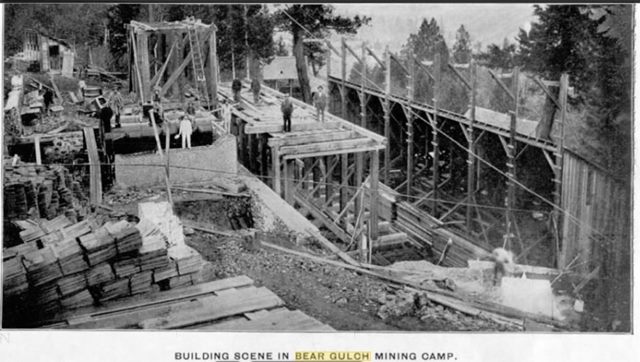
|
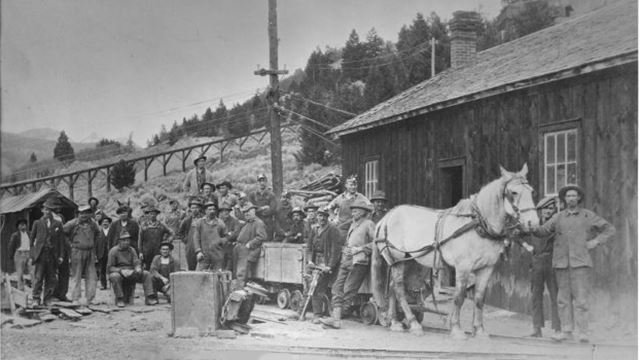 |
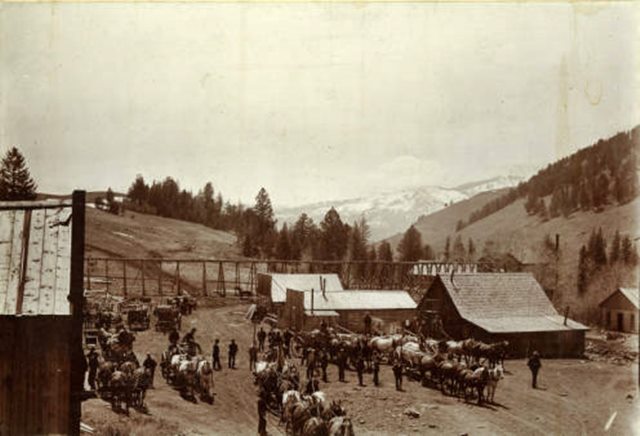 |
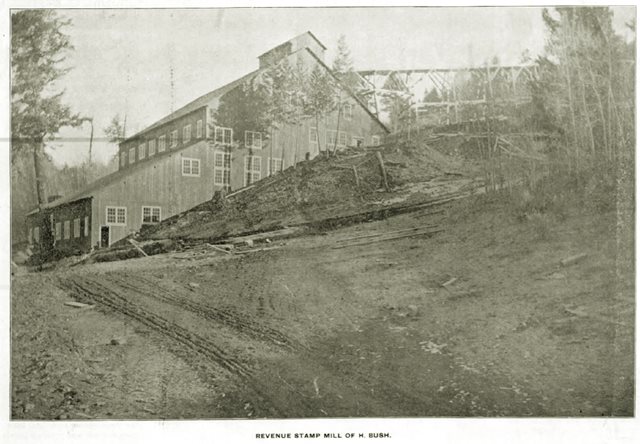 |
Crew near Revenue Mine, 1925
Yellowstone Gateway Museum |
Bear Gulch Scene, 1899
Montana Memory Project |
Revenue Mill, 1899
Livinhston Enterprise, 1 Jan1900
|
|
"However, during this period, Bush struggled with problems obtaining ore with sufficient value to run tthrough his mills, since his most productive mines were tied up in litigation. He continued to process low-grade ore in his mill and problems with other members of the Bear Gulch Mining Company developed. A split in the Bear Gulch Mining Company developed and Bush broke away and formed the Revenue Mining Company, incorporated in Helena on June 21, 1899 . . . By the summer of 1899, Bear Gulch, now renamed Jardine, had two distinct mining groups operating in opposition to each other. These were the old Bear Gulch Mining Company, still under the direction of A.C. Jardine, and the new Bush Company." [Cultural Resource Inventory and Evaluation Project – Jardine, 1982]
|
|
In early 1900 creditors began to press Bush for payments on his huge debt load. After much wheeling and dealing, and many negotiations Bush was forced into bankruptcy. On August 18, 1900, Bush's properties, including the Revenue Mill, 72,000 shares of Bear Gulch Mining Company stock, 275,000 shares of King Solomon Quartz and Placer Company stock, electric light plant, water plant, guest house and mine office buildings, were sold at auction in Livingston, with the First National Bank of Butte the new owner. The short reign of 'King Harry' rapidly came to an end. In the fall, new directors of the Bear Gulch Mining Company were elected with A.C. Jardine, B.C. VanHouten, and Andrew J. Davis representing Montana, while Alfred C. Blair, W.H. Barnaby, and W.G. Merritt from St. John, New Brunswick. Mining and milling again resumed.
|
 |
| Undated View of Jardine, with Mineral Hill and Palmer Mt in the background |
 |
In 1914 the Jardine Gold Mining & Milling Co. was formed to take control of the Jardine gold mines and was renamed the Jardine Mining Co. in 1921. By 1906 tungsten was being mined and milled by the various mining properties. The mineral was found in scheelite, a combination of tungsten and lime, occurring mostly in pockets. Wolframite is tungsten and iron, occurring in regular veins. Tungsten ore ran between $1000 to $1200 per ton, making it more valuable than silver. Mining activity was interrupted by an extended period of litigation from 1909 to 1916 and the mines operated continuously from 1923-26 and 1932-36 producing gold, arsenic and tungsten, but tended to operate off and on until 1948. |
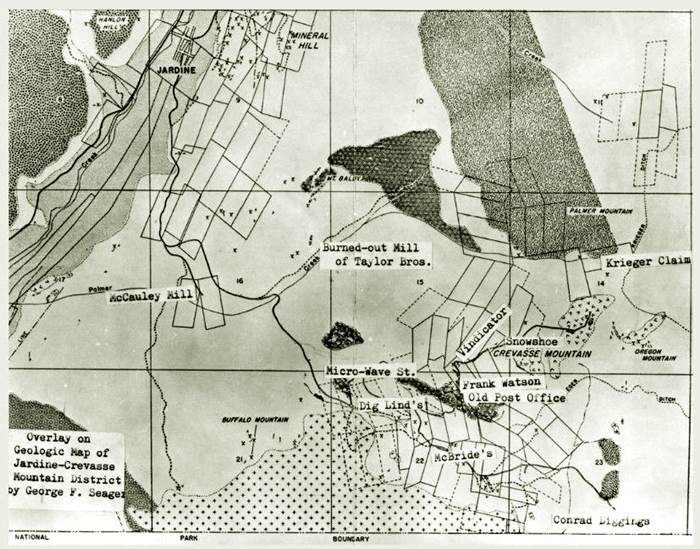 |
Left, Upper: Undated view of Mine Office. It has traditionally been used as the office/headquarterts of all the mine operations.
Library of Congress
Left: Lower: Map of Jardine-Crevasse mining districts, nd.
Jardine Cultural Resource Survey, 1982 |
|
Operations were temporarily suspended in 1942 because of the Federal restrictions on gold mining during WWII, but increasing war demands for arsenic led to the reopening of the mines in 1944, which operated until May 8, 1948, when fire destroyed the cyanide plant and the mines closed down in July. High shipping costs of arsenic ore were claimed as other reasons for the mining shutdown. About 90 men were abruptly thrown out of work
Right: Great Falls Tribune, 14May1948.
|
|
|
Production figures from 1899 -1942 indicate that over 155,000 ounces of gold, 27,000+ ounces of silver, 4,000+ ounces of copper, 765,000+ pounds of tungsten and 12,615,000 tons of arsenic were produced. Perhaps an addition 40,000 ounces of gold were mined 1944-48.
|
 Jardine & Mills, 1969
Jardine & Mills, 1969
YNP Photo 03032 |
In 1988 a new era in gold production began when Homestake Mining, later TVX Gold, Inc. of Canada, began mining efforts with tunnel/adit development, mill and crusher construction and pre-production activities such as erection of administrative and lab facilities. After much controvery regarding potential environment hazards of a mine so close to Yellowstone and potential pollution of the Yellowstone River from Bear Creek, permitting was finally approved and gold production officially began in September of 1889 at the 556-acre Mineral Hill site. The mine operated successfully until early Sept. 1996, when problems of access to new ore bodies dwindling ore supplies from existing workings caused the facility to close and about 130 workers were permanently laid off. Since closure, TVX has removed surface buildings and attempted to restore the area to a natural condition. Treatment of water draining through the tailings pile and from the tunnels continues to be processed to this day. The mine was located two miles from Yellowstone's boundary, five miles by road from Gardiner and produced about 40,000 ounces of gold a year for an approximate total of 260,000 ounces |
|
Today the community supports a small population of about 50 souls and a few businesses such as outfitting, fishing & hunting guides, and vacation rentals. It is a popular area for hiking, biking, horse riding, skiing, and snowmobiling enthusiasts.
Left: Current day view of Jardine
|
Copyright 2018 by Robert V. Goss. All rights reserved. No part of this work may be reproduced
or utilized in any form by any means, electronic or mechanical, including photocopying, recording or by an
information storage and retrieval system without permission in writing from the author. |
Sources:
Bismarch Tribune, various
Bozeman Avant-Courier, various
Bozeman Times, various
Butte Daily Miner, various
Cultural Resource Inventory & Evaluation Project, Homestake Mining Cos, Jardine MT 1982
Goss, Robert V., “And Finding. . . A Hairless Cub, Called the Gulch, Bear. Being an Early History of Bear Gulch and the Sheepeater Mining District.”
Haines, Aubrey L, “The Yellowstone Story,” Vol. 1, Yellowstone Library and Museum Association, 1977.
Helena Daily Independent, various
Livingston Enterprise, various
Livingston Enterprise, 1Jan1900, Park County History Souvenir Edition
Topping, E.S., “The Chronicles of the Yellowstone. Minneapolis: Ross & Haines, Inc., 1968.
Montana DEQ Website, Historic Context, Jardine-Bear Gulch; Crevice Gulch
“Report of the Director of the Mint upon the Production of the Precious Metals in the United States,” US Bureau of the Mint., Govt. Printing Office, 1885.
Whithorn, Bill and Doris, “Photo History of Gardiner, Jardiner, Crevasse.” Livingston, MT: Livingston Enterprise, 1972.
Whithorn, Doris, “Twice Told on the Upper Yellowstone, Vol. 3.” Livingston, MT: Doris S. Whithorn, 2000.
Wolle, Muriel Sibell, “Montana Pay Dirt.” Athens, OH: Swallow Press, Ohio University Press,
|